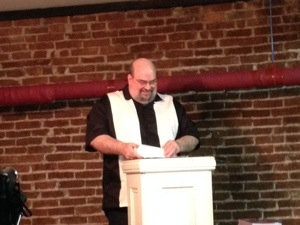This post is Part 1 of 6, for Part 2 click here.
As the premiere (4/6/14) of season four of HBO’s popular “Game of Thrones” series rapidly approaches, I thought the opportunity was ripe for me to gush about how much I have come to enjoy the series and the “Song of Ice and Fire” books upon which it is based. It’s a daunting task to find time to watch – and write about! – three whole seasons but I’ll see how far I can go. I’ve also enlisted the help of another Game of Thrones fan (and in his case the word “fan” may be inadequate!) to help write some of the intended re-watch posts.
A popular debate that, I suppose, goes as far back as the the beginnings of the film industry is the one that goes something like “Did you like the book better, or the movie?” As we might expect, avid readers tend to prefer the books while others prefer the films. In my experience, one format generally outdoes the other. There are rare cases where both seem universally loved or admired. (Gone With the Wind? The Lord of the Rings? Can you think of others?) Rarer still, however, might be the case where a sort of symbiosis occurs. Filmed versions of a literary work help you come to enjoy the written version, which returns the favor. Something like this has occurred with me and George R.R. Martin’s epic fantasy series “A Song of Fire and Ice” – a.k.a. “Game of Thrones” if we use its TV moniker. If you’ve read some of my prior posts on the book series (here and here) written before I’d watched the HBO show, you’ll know I wasn’t always 100% on board the Westeros Train.
****SPOILERS FOLLOW****. This and any subsequent re-watch posts assume you have seen seasons 1-3 AND have read the corresponding depth into the books (about 2/3 of the way through book 3, “A Storm of Swords”)
Okay, with that preamble out of the way, today I’d like to just try to come up with Four Things I Loved (or Loved to Hate) about the first half of season one. Here goes:
1) I LOVED the characters Tyrion Lannister and Arya Stark (and I’ll admit it was somehow gratifying for me to learn that these favorite characters of mine in the books also turned out to be my favorites on the screen. And, as a book blogger, doesn’t one have to love Tyrion? As early as episode two, when he’s on the way to The Wall and Castle Black, young Jon Snow asks him, somewhat disdainfully, “Why do you read so much?” His answer is worth remembering:
“My brother has his sword and I have my mind, and a mind needs books like a sword needs a whetstone. That’s why I read so much…”
Unlike most Lannisters, Tyrion also has redeeming qualities. E.g. he is sympathetic to the injured Bran, sharing schematics for a special saddle that will allow the young prince to be able to ride a horse again. And Tyrion is at his wisecracking best, even when faced with the adversity of imprisonment in one of the Eyrie’s “sky cells” (one of the more stunning visual effects in the series).
(The dreaded “Sky Cell” of the Eyrie)
And feisty little Arya Stark – who cannot love her character? Energetically portrayed by actress Maisie Williams. A tomboy in a world that doesn’t permit them, she prefers swords to the more traditional forms of “needle”point. A favorite scene is when she’s on the stairs with her father, Eddard (“Ned”) Stark and he tells her that someday she’ll marry a prince and be a mother to little princes and princesses. She looks at him rather disappointedly and says “That’s not ME.” I also loved that Ned is such a good father that, realizing Arya’s preferred path, he hires the charismatic swordsman, Silvio Forel of Bravos, to be her “Dancing Master” (that’s “fencing instructor” to you and me). The interplay between Arya and Silvio is great.
(Arya & Silvio’s Pas de Deux)
2. I loved to HATE the characters Joffrey, Peter Baelish, and Theon Greyjoy. The latter was an easy call, as he seemed a little too eager to “euthanize” a direwolf pup in episode 1 and later, after Bran’s injury, when Theon visits Bran’s room, Bran’s direwolf, Summer, growls at him. If dogs can sense the difference between good and evil, surely direwolves must know the difference too. Yes, I’m sure they do.
(Kill a puppy? Sure, I’ll do it! – Theon Greyjoy)
Then we get to the smarmy and unctuous duo, Prince Joffrey and Peter Baelish (a.k.a. Littlefinger). Joffrey’s true colors are shown right away in the incident on the King’s Road in episode two, while Baelisch’s are more slow-cooked over a low flame, I can’t stand either one of them!
(Below: Peter Baelish. Eewww!)
One candidate for a favorite scene of the first half of season one would have to be “the slapping scene” where Joffrey is reprimanded by Tyrion. Yep, I had to rewind that one several times before I was done with it. 🙂
3. I LOVED the “showdown” between Ned Stark and Jaime Lannister, which ends episode five (and is the halfway point in season one) and the slow build-up to it. We first see Ned and Jaime interact with each other at Winterfell in episode one, where their distrust and antagonism is thinly veiled, if that. They have another (verbal) showdown in the throne room (or should I say the Iron Throne Room?) in episode three and you get the sense they may “draw down” (swords in this case, not guns – and what is their eventual showdown if not a classic western gunfight?) on each other even there. Delaying the showdown made me enjoy it even more when it finally happens. And who do you think would have been victorious, if not for the “interference” by one of Jaime’s men? Though an older guy, Ned certainly seemed to be holding his own.
(“High Noon” – King’s Landing Style)
(Oh, Jaime Lannister, the things you do for love…)
4. I loved to HATE King Robert’s “management style.” If you could even say he has one. His ineffectiveness as King is the source of much of the woe that my favorite characters are forced to endure. Ned should have turned him down flat when Robert asked him to serve as The Hand of the King (I loved that title too, and the little stick-pin insignia that gets passed around to the various “HotK’s” throughout the series). Robert’s pathetic kingly traits are showcased after the incident on the King’s Road when he impotently admits “I forgot about the damn wolf” just prior to commanding Ned to kill Sansa’s Direwolf, Lady. Ass.
A bonus “love to hate” would be George R.R. Martin’s shameless rip-off of the culture of the Mongolian Hordes of Genghis Khan and his successors when developing/writing the culture of the savage Dothraki people. Savage in war but not in their language, that is, which was “invented” for the series and sounds beautiful, especially when spoken by Daenerys Targaryen (portrayed by actress, Emilia Clarke). She even looks good with “silver” hair, too.
(below: Viserys and Daenerys Targaryen)
Well, those are “a few of my favorite things” from the first half of season one. What are some of yours? Who did you love, and who did you love to hate? Are you as eagerly anticipating the start of season four as I am?































